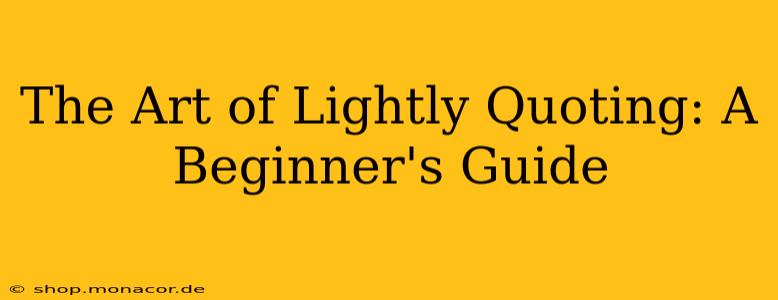Quoting effectively is a crucial skill for writers, researchers, and anyone aiming to integrate external sources into their work. But simply pasting a large chunk of text isn't effective. Mastering the art of lightly quoting – selectively incorporating brief, impactful quotes – elevates your writing, enhances credibility, and avoids plagiarism. This guide will walk you through the essentials.
Why Use Light Quoting?
Heavy quoting often bogs down your writing, disrupting the flow and making your work less engaging. Lightly quoting, on the other hand, offers several advantages:
- Brevity: Concise quotes keep your text focused and readable. Readers appreciate getting to the point without wading through excessive direct quotations.
- Impact: A well-chosen short quote can be far more memorable and powerful than a lengthy paraphrase. It adds punch and authority to your argument.
- Accuracy: Using precise words from the original source ensures you accurately represent the author's ideas without misinterpreting them.
- Credibility: Proper quoting demonstrates your research and strengthens your credibility as a writer.
How to Lightly Quote Effectively
The key is selectivity. Don't quote everything; instead, choose the most relevant and impactful phrases or sentences. Here's a step-by-step guide:
-
Identify Key Ideas: Before you start quoting, identify the most important concepts or arguments you want to convey from the source.
-
Select Short, Powerful Phrases: Focus on extracting only the essential parts of the text that support your point. Avoid quoting entire paragraphs.
-
Integrate Seamlessly: Don't just drop quotes into your writing. Introduce them smoothly with context and explanation. Use signal phrases like: "As X argues," "According to Y," or "In Z's words…"
-
Use Ellipses Appropriately: If you omit words from the middle of a quote, use ellipses (...) to indicate the omission. However, ensure the meaning isn't altered by the omission.
-
Use Brackets for Clarification: If you need to add a word or phrase to clarify the quote's meaning within your context, enclose it in square brackets [ ].
-
Always Cite Your Sources: This is crucial to avoid plagiarism and give credit to the original author. Use a consistent citation style (MLA, APA, Chicago, etc.).
What if I Need to Quote a Longer Passage?
Even with light quoting, sometimes you might need to incorporate a longer excerpt. In this case, consider these alternatives:
- Paraphrasing: Restate the key ideas in your own words. This allows you to maintain a smooth flow while still giving credit to the original source.
- Summarizing: Briefly condense the main points of a longer passage. This is useful when only the general idea is relevant.
- Block Quotation: For exceptionally long or important quotes, use a block quotation (indented, typically without quotation marks). However, use this sparingly, and always provide context and analysis.
Frequently Asked Questions (FAQs)
What is the difference between paraphrasing and quoting?
Paraphrasing is restating information from a source in your own words, while quoting involves directly incorporating the author's exact words. Both require proper citation.
How many quotes should I use in an essay?
The number of quotes depends on your essay's purpose and length. Aim for a balance – enough to support your points effectively without overwhelming the reader.
Can I quote a quote?
Yes, you can quote a quote, but be sure to cite both the original source and the source where you found the quote. This is often indicated with a nested citation (e.g., (Smith, as cited in Jones, 2023)).
What if the original quote contains grammatical errors?
Maintain the original wording, but you can add a note like "[sic]" (meaning "thus," indicating that the error was in the original source).
What are some common mistakes to avoid when quoting?
Common mistakes include over-quoting, poor integration of quotes, omitting necessary citations, and altering the meaning of the quote.
By mastering the art of lightly quoting, you can enhance the clarity, impact, and credibility of your writing. Remember, less is often more when it comes to incorporating external sources into your work.

